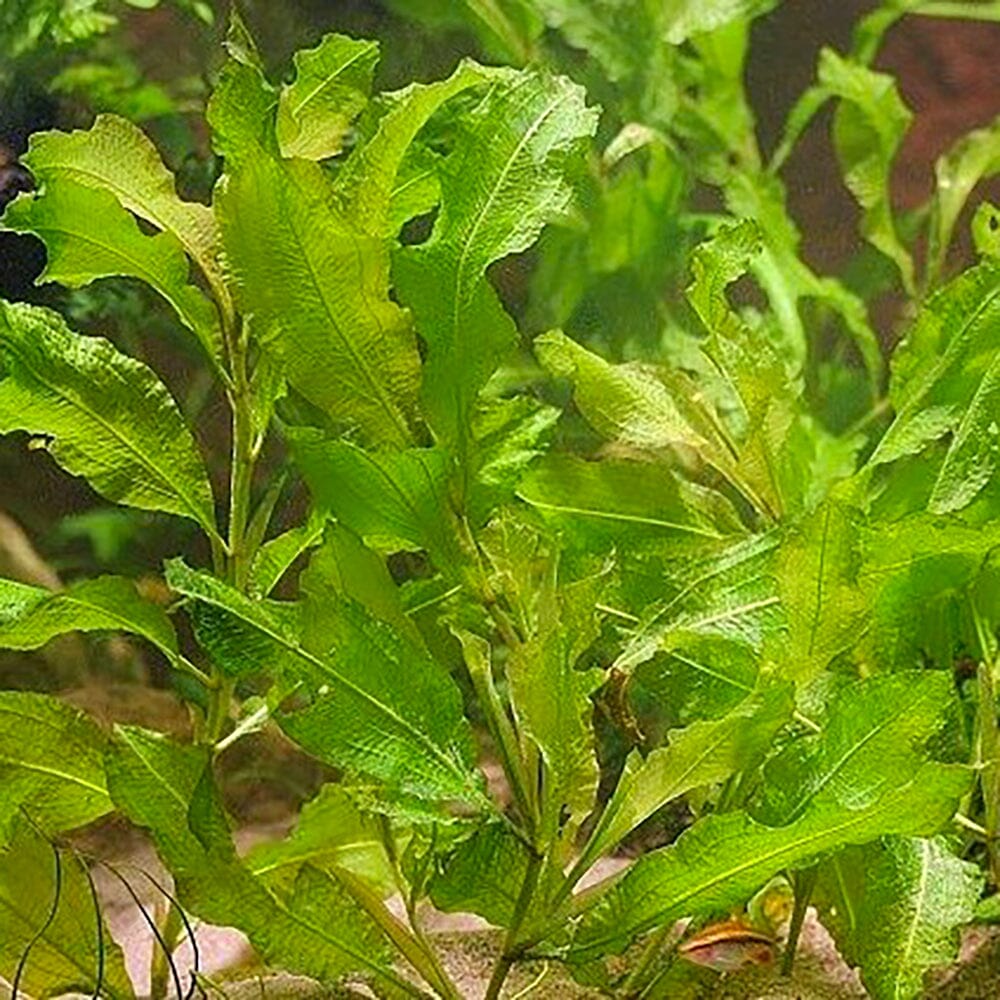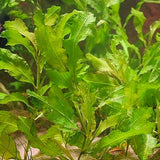Potamogeton Lucens Aquatic Pond Plant - Sining Pondweed
Potamogeton lucens, commonly known as shining pondweed or curled pondweed, is an aquatic plant species that is native to Europe and parts of Asia. It is popular among aquatic plant enthusiasts and is commonly used in aquariums and ponds due to its attractive appearance and ease of care. Here is a detailed description and care guide for Potamogeton lucens:
Description:
Potamogeton lucens has long, slender, and flexible stems that can reach lengths of up to 1 meter (3 feet). The leaves are bright green, translucent, and narrow, typically measuring around 5-10 cm (2-4 inches) in length. The leaves have a slightly wavy or curled appearance, giving the plant its common name. The plant may produce small flowers that are often inconspicuous.
Care Guide:
Lighting: Potamogeton lucens prefers moderate to high lighting conditions. Provide at least 2-3 watts per gallon of full-spectrum light to promote healthy growth.
Water Parameters:Maintain a water temperature between 18-26°C (64-79°F). The pH level should be slightly acidic to slightly alkaline, ranging from 6.5-7.5. The water hardness can vary, but a range of 3-12 dGH is generally suitable.
Substrate: Potamogeton lucens can be grown with or without a substrate. If grown without substrate, the plant can be anchored using weights or placed in mesh pots filled with aquatic plant substrate or clay. If grown with substrate, a nutrient-rich substrate can help support its growth.
Nutrient Requirements: Regular fertilization is important to provide essential nutrients to Potamogeton lucens. Liquid fertilizers or root tabs can be used to supply macro and micronutrients. Carbon dioxide (CO2) supplementation is not necessary but can promote faster growth and denser foliage if desired.
Water Flow and Oxygenation: Potamogeton lucens prefers moderate water flow. It benefits from water movement to distribute nutrients and prevent debris from accumulating on the leaves. Adequate water movement also promotes oxygenation, benefiting both the plant and aquatic organisms.
Propagation: Potamogeton lucens can propagate through runners or by planting stem cuttings. Healthy side shoots or stems can be trimmed and replanted in the substrate or floated on the water's surface to develop new plants.
Compatibility: Potamogeton lucens is generally compatible with a variety of fish and invertebrates. It provides cover and spawning areas for fish and serves as a habitat for aquatic organisms. However, be mindful of potential herbivorous fish that may nibble on the leaves.
Regular maintenance, including trimming and nutrient supplementation, will help maintain the health and appearance of Potamogeton lucens. Monitor the plant for any signs of nutrient deficiency or excessive growth, as well as the overall condition of the aquarium or pond. With proper care, Potamogeton lucens can create a lush and natural aquatic environment.
Selection of Plants:
Choose appropriate oxygenating plants that are suitable for the size and depth of your pond. Common oxygenating plants include Hornwort (Ceratophyllum), Anacharis (Elodea canadensis), Waterweed (Elodea densa), and Watermilfoil (Myriophyllum species).
Placement:
Place oxygenating plants in the water at a depth where their foliage is fully submerged. Distribute the plants evenly throughout the pond, ensuring they receive adequate sunlight for photosynthesis.
Water Quality:
Oxygenating plants play a crucial role in maintaining good water quality by absorbing excess nutrients, competing with algae for resources, and releasing oxygen through photosynthesis. Regularly monitor water quality parameters such as pH, ammonia, nitrite, and nitrate levels to ensure they are within suitable ranges for the plants.
Nutrient Levels:
Oxygenating plants benefit from moderate nutrient levels in the water, but excessive nutrients can lead to rapid algae growth. Avoid over-fertilization or excessive organic matter accumulation in the pond, as it can negatively impact oxygenating plants.
Pruning and Maintenance:
Regularly thin out and prune oxygenating plants to prevent overcrowding and ensure healthy growth. Remove any dead or decaying plant material promptly to maintain water quality and prevent the release of excess nutrients.
Winter Care:
Some oxygenating plants may need special attention during winter, especially in colder climates. If your pond experiences freezing temperatures, consider moving potted plants indoors or provide insulation to protect them. In milder climates, oxygenating plants may continue to grow during winter, providing oxygen and supporting the pond ecosystem.
Propagation:
Some oxygenating plants can be propagated by dividing or taking cuttings. Follow specific instructions for each plant species to propagate them successfully and maintain a healthy population in your pond.
Monitoring and Control:
Regularly observe the growth and condition of oxygenating plants to identify any signs of disease, pests, or nutrient deficiencies. If needed, control excessive growth by removing excess plant material, but be careful not to remove too much at once, as it can disturb the pond's ecological balance.
Introduction of New Plants:
Before introducing new oxygenating plants into your pond, ensure they are free from pests, diseases, or invasive species. Avoid introducing non-native species that may become invasive and harm the local ecosystem. By following these general tips and care guidelines, you can maintain healthy oxygenating plants in your pond. They will contribute to the overall oxygenation of the water, provide habitat for beneficial organisms, and promote a thriving pond ecosystem.






























